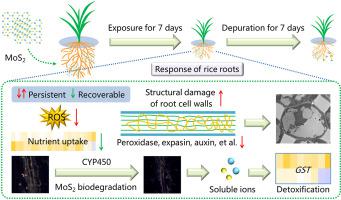Chemosphere ( IF 8.1 ) Pub Date : 2023-02-15 , DOI: 10.1016/j.chemosphere.2023.138166 Wei Zou 1 , Chenxu Zhao 1 , Jiayi Chen 1 , Yihan Wang 1 , Caixia Jin 1 , Xingli Zhang 1

|
The increasing application of engineered nanomaterials (ENMs) unavoidably leads to environmental release and biological exposure. Understanding the potential hazards of ENMs on crops is essential for appropriate utilization and management. Herein, rice seedlings were hydroponically exposed to molybdenum sulfide (MoS2, a typical ENM) nanosheets at 5−20 mg/L for 7 days and then depurated for another 7 days in a fresh culture medium. Exposure to MoS2 triggered irreversible reductions in root length (by 26.3%–69.9%) and tip number (by 22.2%–66.0%). Integration of biochemical assays, transcriptomic and metabolomics found that oxidative stress induced by MoS2 in roots was persistent, whereas the activation of aquaporins, ionic transportation, and energy synthesis was normalized due to the recovery of nutrient uptake. The down-regulated levels of genes and metabolites associated with peroxidases, hemicellulose synthesis, expansins, and auxins caused persistent structural damages (sclerosis and rupture) of root cell walls. Approximately 64.5%–84.8% of internalized MoS2 nanosheets were degraded, and the successive up-regulation of genes encoding cytochrome P450s and glutathione S-transferases reflected the biotransformation and detoxification of MoS2 in the depuration period. These findings provide novel insights into the persistence and recovery of MoS2 phytotoxicity, which will help advance the risk assessment of MoS2 application on environment.
中文翻译:

水稻 (Oryza sativa L.) 根对二硫化钼纳米片的系统胁迫持续性和恢复模式
工程纳米材料 (ENM) 的应用越来越多,不可避免地会导致环境释放和生物暴露。了解 ENMs 对作物的潜在危害对于适当利用和管理至关重要。在此,将水稻幼苗水培暴露于 5-20 mg/L 的硫化钼(MoS 2,一种典型的 ENM)纳米片中 7 天,然后在新鲜培养基中再净化 7 天。暴露于 MoS 2会引发根长度(减少 26.3%–69.9%)和尖端数量(减少 22.2%–66.0%)的不可逆减少。生化分析、转录组学和代谢组学的整合发现 MoS 2诱导的氧化应激根中的活性持续存在,而水通道蛋白的激活、离子运输和能量合成由于养分吸收的恢复而正常化。与过氧化物酶、半纤维素合成、扩张蛋白和生长素相关的基因和代谢物水平下调导致根细胞壁的持续结构损伤(硬化和破裂)。大约 64.5%–84.8% 的内化 MoS 2纳米片被降解,编码细胞色素 P450 和谷胱甘肽S-转移酶的基因的连续上调反映了 MoS 2在净化阶段的生物转化和解毒。这些发现为 MoS 2的持久性和恢复提供了新的见解植物毒性,这将有助于推进MoS 2应用对环境的风险评估。















































 京公网安备 11010802027423号
京公网安备 11010802027423号